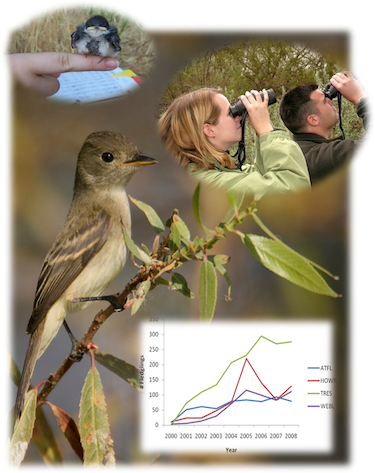Putah Creek Wildlife Monitoring
Putah Creek Biomonitoring

For over twenty years, the MWFB’s Putah Creek Biomonitoring Program (PCBP) has surveyed fish and wildlife along Putah Creek. The PCBP arose from the Putah Creek Accord, an historic agreement that restored water flows to lower Putah Creek after decades of restriction. This monumental restoration project called for a team to assess its outcomes, and the MWFB has been conducting research along the creek ever since.
Putah Creek provides important habitat for wildlife. It functions as a habitat corridor linking the Berryessa mountains to the valley and serves as migratory pathway between northern California and the Central Valley. The PCBP seeks to better understand Putah Creek’s ecosystem in order to guide habitat management actions. In this way, the MWFB can advise in the development of new projects and adaptive management strategies that consider the needs of both wildlife and people along the creek.
The PCBP conducts annual surveys for both animals and plants. Birds are our primary focus group, due to their value as indicators of what’s happening in the environment. We conduct several different types of avian assessments (point count surveys, transect surveys, and breeding bird studies) that characterize the diversity, population dynamics, and reproductive status of birds along the creek. To date, we have documented over 250 species of birds! We have also recorded 49 species of mammals, 12 reptiles, and 4 amphibians. Recently, we launched an acoustic survey program for bats, which has already documented 15 different species. For plants, data is collected from permanent sampling plots and condition assessments.
Our research centers on spatial and temporal avifaunal patterns along the creek and our long-term data sets serve as a regional baseline for wildlife response to a changing climate. The PCBP has sponsored student research; conducted comparative studies between Putah Creek and other riparian regions; participated in MAPS avian mist netting efforts for the Institute for Bird Populations; and participated in a formal process to develop habitat restoration plans for 30 miles of lower Putah Creek. The PCBP also maintains an active education and outreach presence within UC Davis and throughout the community, conducting and participating in field trips, lectures, workshops, and other activities. We hope to continue advancing research and sharing our work for years to come.
Publications
Dybala, K. E., Engilis, Jr., A., Trochet, J. A., Engilis, I. E., and Truan, M. L. Evaluating Riparian Restoration Success: Long-Term Responses of the Breeding Bird Community in California’s Lower Putah Creek Watershed. Ecological Restoration. 2018; Vol 36, No. 1: 76-85.
Walsh, R. G. Subsidized Food Webs: Isotopic Tracking of Trophic Interactions and Riparian Songbird Ecology. PhD Dissertation, University of California, Davis. 2018.
Trochet, J. A., Engilis, Jr., A., Truan, M. L., Engilis, I. E., Walsh, R. A., Whisler, E., and Dybala, K. E. New and Extralimital Records of Breeding Birds for Putah Creek, California. Western Birds. 2017; Vol. 48, No. 3: 154-172.
Dybala, K. E., Truan, M. L., and Engilis, Jr., A. Summer vs. winter: Examining the temporal distribution of avian biodiversity to inform conservation. The Condor. 2015; Vol. 117: 560-576.
Trochet, J. A. and Engilis, Jr., A. Tracy Storer and the bird life of Putah Creek in by-gone days. Central Valley Bird Club Bulletin. 2013; Vol. 16, No. 3: 70-86.
Truan, M. L., Engilis, Jr., A., and Trochet, J. A. Putah Creek Terrestrial Wildlife Monitoring Program: Comprehensive Report 1997-2009. 2010. Department of Wildlife, Fish, and Conservation Biology, Museum of Wildlife and Fish Biology. University of California, Davis.
